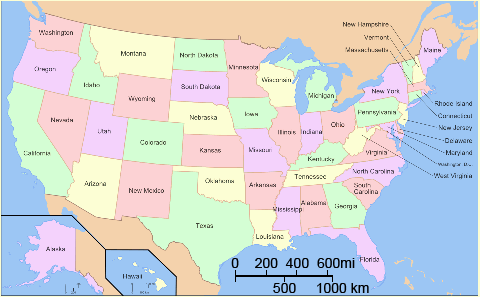Map scale
A map scale is a ratio between the dimensions on a map and the dimensions of the area represented by the map. In other words, the map scale tells us the relationship between a distance on the map and how much actual ground it represents.
One way to write a map scale is as a ratio along with a statement of the distances involved. It is usually part of the map's key (or legend). For example:
1:100,000 1 cm = 1km
This means that 1 centimeter on the map is equivalent to 1 kilometer, or 100,000 centimeters.
Another way to show a map's scale is to use a line segment to show a specific length on the map (which could actually be a centimeter, like above, but doesn't have to be) and state what distance that line segment represents relative to the actual ground distance on Earth. Refer to the figure below:

In the map of the United States above, we see two scales; one for miles and the other for kilometers. To use the scale, we use a ruler to measure the length of the line segments. The total measured length of each line segment would be equivalent to 200 miles or 500 kilometers of Earth's surface. The scale is also often broken down into smaller segments, so we could measure 50 miles or 200 kilometers instead if we wanted a smaller increment.
One advantage of this method is that the length will scale even if the size of the map changes. For example, if the map you're looking at were an image that you printed off the Internet, if you were to have altered the size of the image, and the key only stated "1 cm = 1km" rather than having a line segment you could measure, 1 cm would no longer accurately represent 1km, since the size of the map has changed.
